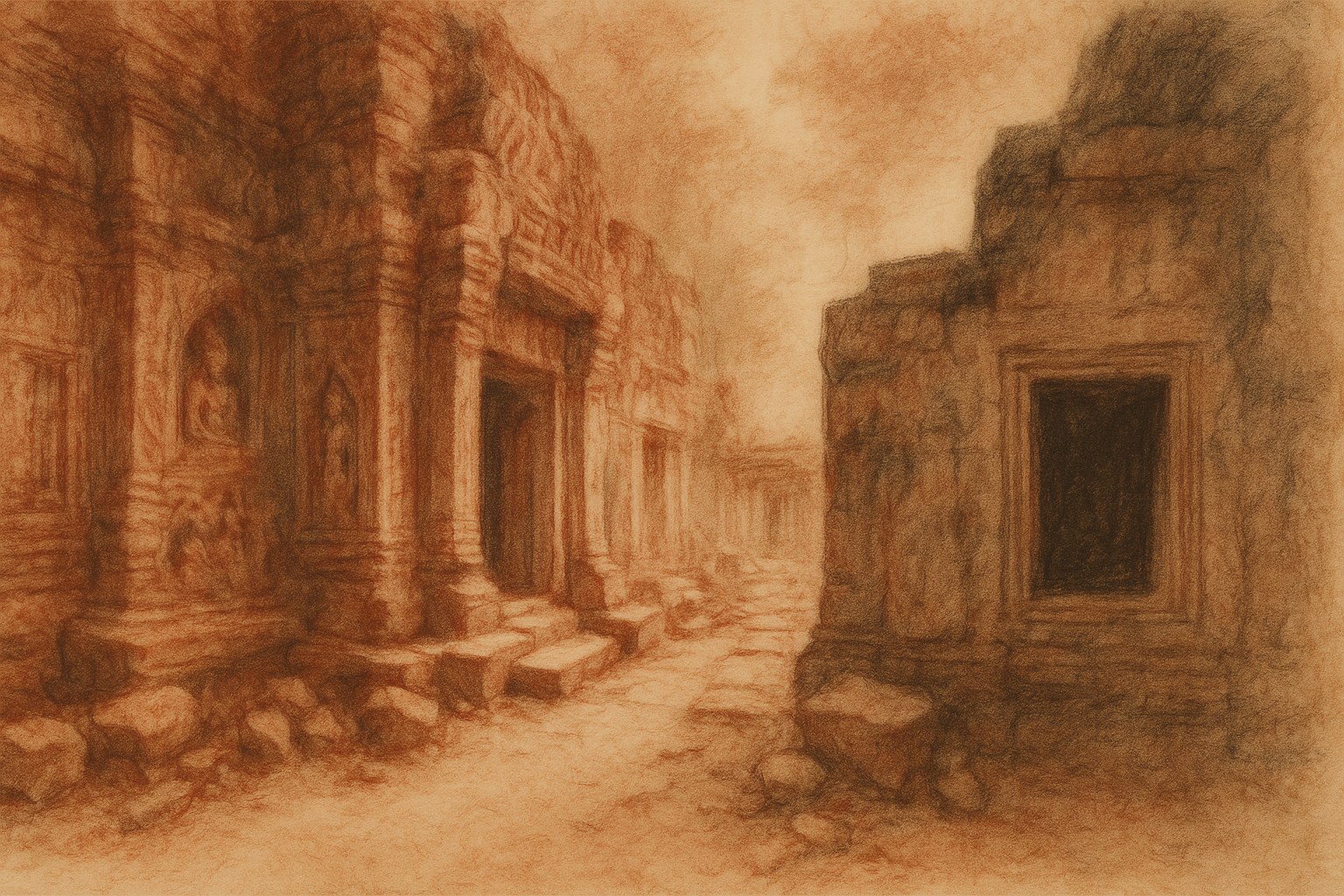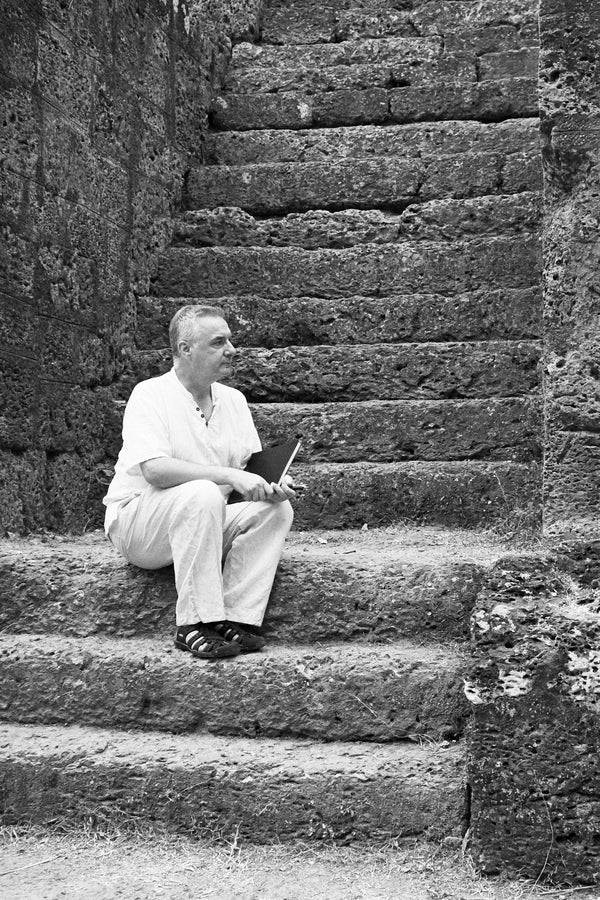Complimentary worldwide shipping on orders over $400 · No import tariffs for most countries
Complimentary worldwide shipping on orders over $400 · No import tariffs for most countries

Where Roots Hold the Ruin Like Prayer
Ta Prohm · Southern Section — July 2025
“Where roots hold memory and silence becomes prayer”
Last night’s storm passed without spectacle—no lightning fanfare, no roar of thunder—only the steady hush of rain falling through leaf and stone. When we rose, its blessing still clung to the earth. The path to Ta Prohm was damp and dark, the scent of wet bark and temple moss already rising. Annie and I rode in silence beneath the dripping canopy, our wheels brushing softly through saturated earth. The jungle exhaled mist. The forest felt watchful, as though something sacred had just stepped beyond the veil.
We entered not by the western gate—grand, restored, already preparing for the day’s procession—but through the eastern threshold, where the ruin breathes without ornament. Here, the stones remain uncorrected, their alignments faltering, their gestures unfinished. But the temple still faces the dawn, as it always has. To approach from the east is not a preference of direction—it is an offering of posture. The axis is reverence.
The sky had just begun to burn—clouds lit from below like coals beneath a sacred bowl. The moon still floated high, round and pale. From the village behind, roosters called to the sun. Cicadas responded. And for a moment, all was suspended—between moon and flame, stillness and sound.
We passed the dharmasala first—the house of fire. A pilgrim’s rest from Jayavarman’s reign, built of laterite, still dark with dew. The old doorframes held the scent of salt and ash. I placed my palm on the stone. It felt warm, as if the ancient flame still lingered in the marrow of the walls.
Crossing the moat, we entered the fifth enclosure. Ninety-three monk cells lined the path ahead—simple, aligned, serene. Their presence lingers not in image, but in breath. A laterite wall still divides the world of the monks from the sacred interior—a veil of stone one must exhale through to cross.
Within the core, Ta Prohm lives. It does not survive. It breathes. Even now—after all these years, after a thousand walks—its first glimpse still empties me. I do not remember this place. I meet it. And it meets me back.
As we moved through the galleries, the light crept behind us—slow, golden, hushed. The great spung trees shimmered overhead. Their roots—massive and tender—held the stone not to break it, but to remain. We paused before a Buddhist panel I had sketched before. Its central figure, once Buddha, had long been erased. But the kneeling devotees remained. So did the praying garudas above, sheltered in the arms of a sacred tree. The absence itself had presence. Even void, the stone holds its vow.
Southward, the hush deepened.
There, between two sanctuaries, I paused. A corridor revealed itself—not a passage, but a stillness. To the left: divine apsaras and sealed niches. To the right: a broken wall, its hollow window a darkened eye. Beneath us, scattered stones lay like bones of prayer—placed, not fallen. I opened my sketchbook, and let the chalk move slowly—guided not by sight, but by silence.
stone wall womb-silent
leaves tremble on fallen lintel—
light bows into dust

A still corridor between guardians and shadowed eye
Annie knelt near a corner shrine and lit incense—three sticks, always three. The smoke rose slowly, curling like unspoken names. We whispered prayers—for our friends, for those we could not reach. She sat in stillness. I let the sketch become its own kind of prayer.
Deeper in the southern wing, we stood before the pediment of the Great Departure. There, Prince Siddhartha rides into silence. His horse steps softly, its hooves lifted by divine hands so no one he loves will wake. I have photographed this scene before—on large-format film, beneath overcast skies. But this morning, it shone from within. Sorrow, radiant and unbearable.
Not far beyond, a sanctuary had collapsed inward. Its carved doorway still stood, noble and hollowed. The chamber behind had fallen. In the threshold, the rubble of time—blocks, carvings, fragments still breathing with shape. And among them, a tree. Its trunk leaned gently into the ruin, roots wrapping the stones not to take, but to cradle. I sketched slowly—each line a touch, each curve a breath.

A fallen chamber held by tree and time
We moved on in silence. At another chapel, a pediment revealed the tale of Prince Vessantara. He gives his children to the Brahmin Jujaka, sealing the offering with water poured from his hand. Between them, the children—one broken. Below, a chariot waits, uninhabited. The carving pulsed with ache. It did not ask to be understood. Only received.
Nearby, a devata stood holding a cup. Around her danced medallions—an elephant, a man with baskets, strange beings half-remembered. On the lintel above, Lokeshvara—gentle, wide-eyed, arms extended in peace. Even in erasure, compassion remains.
Inside, the walls still bore faint traces of white plaster. I touched it with care—it crumbled softly beneath my fingers like breath fading into wind. A sacred deposit stone lay on the ground like a still heart beneath the temple’s skin.
In the outer galleries, the rhythm of sanctuaries continued—aligned like mantras nearly three hundred meters long. Each once held a Buddha image—now mostly gone. But the gestures remain. Stone remembers posture. Along the base, nagas ripple across the sandstone—serpents like sacred breath, repeating what the lips no longer chant.
Among the pilasters, I found a medallion. A seated figure, struck by two men with saw-like tools. His face had been chiselled away. Some say it is Mara’s assault. Others, a scene from the Temiya Jataka—the silent prince who endured all torments in stillness. The scholars differ. But the carving remains. And the mercy remains with it.
Then I found her.
An apsara framed in flame—carved in high relief, yet still weightless. One bird perched on her shoulder, another on her hand, a third clinging to a lotus stem curling from her wrist. In her lowered hand, she held a full lotus—trailing like water, like grace. I sketched her slowly. Not to capture her, but to receive her. The chalk followed her silence.

Apsara of three birds and the lotus of stillness
Just before we turned back, one last image held me: three towering spung trees, rising from the bones of a ruined gallery. Their trunks shone in the golden light. Their roots wrapped the stone not to possess, but to remember. I made one final sketch—not to preserve, but to offer.
Three trees, one breath—
each root a hand,
each stone a vow.
They do not speak,
but they remember.
The gallery crumbles.
Yet something remains—
the silence of holding
without taking.

Roots that remember, stone that dreams
We passed again through the eastern gate, morning grown bright. Tourists wandered now, voices rising, laughter like startled birds. But we had already left something behind. And taken something in return. It rests now—in the sketchbook, in the silence, in the breath between stones.
We rode home through a warming world, the scent of wet earth still clinging to us. I said nothing. Some mornings do not need to be remembered. Only received.
Let the stone remember what the soul cannot keep.
Ta Prohm Temple
Beautiful museum quality archival prints on fine art paper depicting the ancient Ta Prohm Temple in the Angkor Archaeological Park in Cambodia.
Join My Studio Journal
Receive occasional letters from my studio in Siem Reap—offering a glimpse into my creative process, early access to new fine art prints, field notes from the temples of Angkor, exhibition announcements, and reflections on beauty, impermanence, and the spirit of place.
No noise. No clutter. Just quiet inspiration, delivered gently.
Subscribe and stay connected to the unfolding story.

Join My Studio Journal
Receive occasional letters from my studio in Siem Reap—offering a glimpse into my creative process, early access to new fine art prints, field notes from the temples of Angkor, exhibition announcements, and reflections on beauty, impermanence, and the spirit of place.
No noise. No clutter. Just quiet inspiration, delivered gently.
Subscribe and stay connected to the unfolding story.















